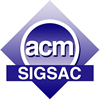Reproducibility Label
This year WiSec is pioneering a process to support greater reproducibility in mobile and wireless security experimental research. The goal of this process is to increase the impact of mobile and wireless security research, enable dissemination of research results, code and experimental set-ups, and to enable the research community to build on prior experimental results. Towards this goal, WiSec is introducing a reproducibility label to recognize papers whose results were reproduced by an independent reproducibility committee. Authors of accepted papers can participate in this voluntary process by submitting supporting evidence of their experiments’ reproducibility, following the instructions below. Authors are encouraged to plan ahead when running their experiments, in order to minimize the overhead of applying for this label.
In this first iteration, the authors will:
- Prepare a VirtualBox VM with all data/tools installed. It is expected that the authors include within this VM raw data (without any pre-processing) and all the scripts used for pre-processing.
- For each graph/table, provide a directory (Fig_XXX, Table_XXX) which contains a script that enables the committee to regenerate that object.
- Include in the home directory a readme file, according to the following format. The authors can use the following script to generate information about the configuration of the machine that was used for the experiments.
- Provide a link to downloading the VM (e..g, google drive or dropbox), or request credentials to upload the VM to the conference storage system.
- Submit a request on easychair (https://easychair.org/conferences/?conf=wisec17reproducibili) and include a link within the abstract to your VM. [Deadline: June 2, 2017]
If the committee can verify that all relevant data sets were included and the graphs/tables can be regenerated based on this, the committee will grant a Reproducibility Label and also provide a report on the regeneration process.
Reproducibility Committee:- Guevara Noubir (Chair), Northeastern University
- Paul Patras, University of Edinburgh
- Aanjhan Ranganathan, ETHZ
- Triet Vo-Huu, Northeastern University
List of reproducibility submissions:
- Massive Reactive Smartphone-Based Jamming using Arbitrary Waveforms and Adaptive Power Control

Matthias Schulz (Technische Universität Darmstadt, Germany), Francesco Gringoli (University of Brescia, Italy), Daniel Steinmetzer (Technische Universität Darmstadt, Germany), Michael Koch (Technische Universität Darmstadt, Germany), Matthias Hollick (Technische Universität Darmstadt, Germany) - Binary Hash Tree based Certificate Access Management for Connected Vehicles

Virendra Kumar (OnBoard Security), Jonathan Petit (OnBoard Security), William Whyte (OnBoard Security) - Physical-Layer Fingerprinting of LoRa devices using Supervised and Zero-Shot Learnin

Pieter Robyns (UHasselt - tUL - imec), Eduard Marin (ESAT-COSIC and imec), Wim Lamotte (UHasselt - tUL - imec), Peter Quax (UHasselt - tUL - imec), Dave Singelée (ESAT-COSIC and imec), Bart Preneel (ESAT-COSIC and imec) - An Autonomic and Permissionless Android Covert Channel

Ken Block (Northeastern University), Sashank Narain (Northeastern University), Guevara Noubir (Northeastern University) - Trashing IMSI Catchers in Mobile Networks

Mohammed Shafiul Alam Khan (ISG, Royal Holloway, University of London), Chris J Mitchell (ISG, Royal Holloway, University of London) - Resilient Privacy Protection for Location-Based Services Through Decentralization

Hongyu Jin (KTH), Panos Papadimitratos (KTH)


Important Dates
- Abstract submission: March 27, 2017 (11:59:59 PM EDT) [Open until Paper Deadline]
- Paper submission: March 27, 2017 (11:59:59 PM EDT) [Hard Deadline]
- Notification to authors: May 1, 2017
- Poster and demo proposal submission: June 2, 2017
- Camera-ready version: May 29, 2017
- WiSec 2017: July 18 to July 20, 2017
Sponsored by
ACM WiSec 2017
10th ACM Conference on Security
and Privacy in Wireless and
Mobile Networks
Boston, USA
July 18 - 20, 2017








